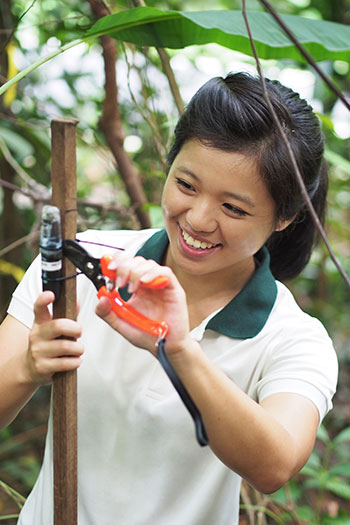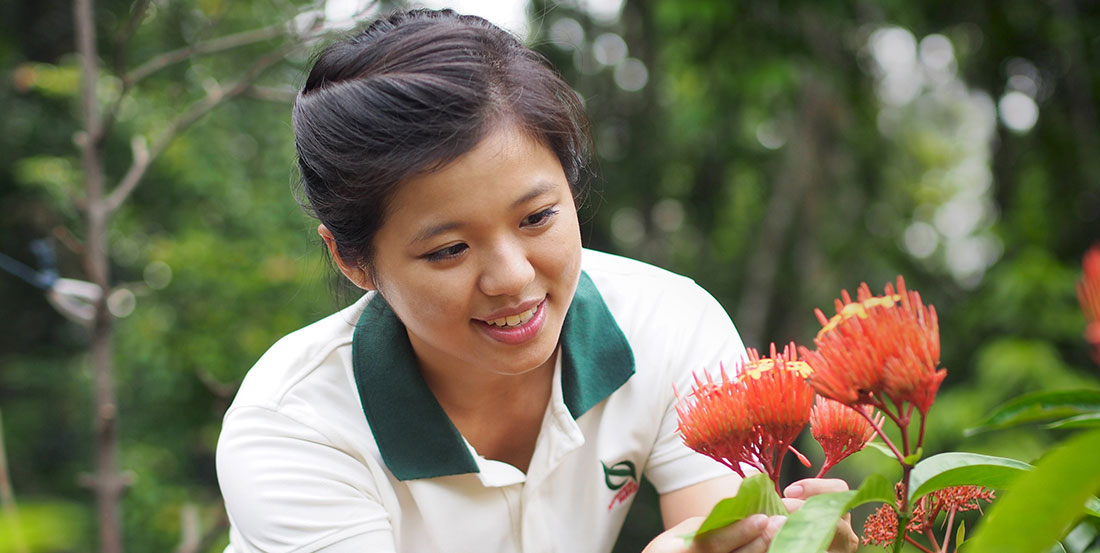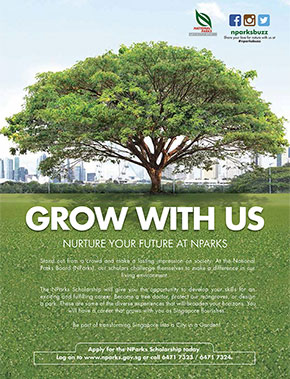The island of Singapore is populated with a unique mix of urban infrastructure and lush greenery. Despite the rapid pace of modernisation and urbanisation that our country is going through, the health of our natural environment is always on the forefront of our minds.
The organisation that is helping flora and fauna flourish in our country is National Parks Board (NParks), whose vision is to enhance Singapore’s reputation as a ‘City in a Garden’. We talk to NParks scholar Lim Siu An, who is Manager of Horticulture & Operations now, to find out more about how the organisation continues to develop our city’s greenery and nature areas.
Tell us about your job at NParks.
I am part of the Singapore Botanic Gardens’ Horticulture & Operations team, helping to manage the Learning Forest. The Learning Forest is a conservation site for some very precious plant species, and is home to a healthy population of the Critically Endangered palm, Orania sylvicola. In Singapore, fewer than five palms are thought to exist outside the Learning Forest. As a manager of the area, I am responsible for making the place friendly, not just for visitors from Singapore and overseas, but also for all the wildlife that visits the Learning Forest.
Share with us how your passion for environment and plant science developed.
My love for nature started when I was very young. As a child, I have always looked forward to being outdoors, trudging through mud and climbing trees. Later as a teenager, I started to appreciate the value of having greenery in our environment. This grew into a love for urban landscapes – not just for the beauty, but also for the manifold benefits to the urban ecosystems and to humans. In particular, the idea that the temperature of an entire city depended on its green coverage fascinated me.

One of Siu Ann’s responsibility is ensuring that the ground conditions are optimal for the growth of flora and fauna at the Singapore Botanic Gardens. Here she is attaching a temperature and humidity data logger to monitor the microclimate in the Gardens’ Rain Forest.
Lim Sui Ann
NParks Overseas Undergraduate Scholar
Manager of Horticulture & Operations, Singapore Botanic Gardens
How has your overseas undergraduate scholarship experience benefitted you?
I was given the opportunity to satisfy my curiosity for urban greenery. I pursued a Bachelor of Science, majoring in Plant Science at the University of Melbourne, which laid the foundational knowledge for my final year at university when I had the privilege of taking on a research project on vertical greenery. That year, I was part of the University’s Green Infrastructure Research Group. This was where I interacted with other researchers to develop my ideas and widen my perspectives on green infrastructure.
My time overseas really fuelled my passion for urban greenery. I got to see how wide the breadth of flora study in Australia was. Singapore’s study is currently on a smaller scale than that of Australia’s, but it is expanding quickly. With my experience in Australia, I hope to assist in projects such as ‘Flora of Singapore’, which aims to catalogue and describe all plant species that can be found in Singapore to help further our country’s botanical knowledge.
What kind of career and learning opportunities can employees look forward to at NParks?
At NParks, no two days are the same and there has hardly been a dull moment since I joined. There is just so much to learn from the large pool of expertise in different fields within the organisation - from plants, animals to park development and water management, amongst many others.
When I first joined NParks, I was involved in developing the Learning Forest. Seeing the development, completion, and opening of this conservation site has been one of the most fulfilling parts of my term with NParks so far.
Furthermore, being part of an agency that plays a key role in determining the greenery of Singapore gives me an opportunity to work with many other agencies. For the development of the Learning Forest, I worked with the Public Utilities Board as well as the Land Transport Authority. The experience has given me insights into the multifaceted considerations undertaken by different agencies to see a developmental project to fruition.
How does NParks stay relevant and a leader in the changing environmental landscape of today?
Those observing the landscapes in Singapore would have realised the changes in greenery in the past few decades. This is all due to the work of NParks officers who have been pushing and challenging the limits of the tropical urban landscape to meet the needs of Singaporeans. Officers are continuously trying out new native plant species that can grow in urban areas so that our landscapes are not only uniquely Singaporean, but will also be beneficial to the communities of flora and fauna that they are connected to.
In addition, NParks conducts in-house research. The Centre of Urban Greenery and Education (CUGE) is a division of NParks that conducts research relevant to the landscape industry. Having an in-house research team allows for a seamless transition of a trial from the research phase to its implementation. CUGE works directly with horticulture teams to trial and implement systems in Singapore’s parks and gardens.
Singapore is an internationally renowned City in a Garden. How do you aspire to contribute to this legacy with your work?
A City in a Garden does not stop at growing things on bare ground and greening up concrete structures. Our greenery needs to be maintained sustainably. To ensure sustainable management, the output from our greenery ought to be ploughed back to the system to reduce artificial inputs of fertilisers, soil conditioners, and other chemical amendments. At present, we are working on recycling leaf litter by bringing in swept leaves from all over Singapore into the Singapore Botanic Gardens to use as mulch. The areas that we are collecting leaf litter from is increasing, and I hope that the practice of leaf mulching becomes used more widely across our island nation – for the betterment of our carbon footprint and for the health of our trees!

